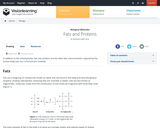
13 Results


Biology is designed for multi-semester biology courses for science majors. It is grounded on an evolutionary basis and includes exciting features that highlight careers in the biological sciences and everyday applications of the concepts at hand. To meet the needs of today’s instructors and students, some content has been strategically condensed while maintaining the overall scope and coverage of traditional texts for this course. Instructors can customize the book, adapting it to the approach that works best in their classroom. Biology also includes an innovative art program that incorporates critical thinking and clicker questions to help students understand—and apply—key concepts.
- Subject:
- Biology
- Life Science
- Material Type:
- Full Course
- Provider:
- Rice University
- Provider Set:
- OpenStax College
- Date Added:
- 08/22/2012

- Subject:
- Biology
- Life Science
- Material Type:
- Unit of Study
- Provider:
- Rice University
- Provider Set:
- OpenStax College

- Subject:
- Applied Science
- Biology
- Life Science
- Material Type:
- Module
- Date Added:
- 07/10/2017

By the end of this section, you will be able to:Describe the four major types of lipidsExplain the role of fats in storing energyDifferentiate between saturated and unsaturated fatty acidsDescribe phospholipids and their role in cellsDefine the basic structure of a steroid and some functions of steroidsExplain the how cholesterol helps to maintain the fluid nature of the plasma membrane
- Subject:
- Applied Science
- Biology
- Life Science
- Material Type:
- Module
- Date Added:
- 07/10/2017

By the end of this section, you will be able to:Describe the four major types of lipidsExplain the role of fats in storing energyDifferentiate between saturated and unsaturated fatty acidsDescribe phospholipids and their role in cellsDefine the basic structure of a steroid and some functions of steroidsExplain the how cholesterol helps to maintain the fluid nature of the plasma membrane
- Subject:
- Applied Science
- Biology
- Life Science
- Material Type:
- Module
- Author:
- Tina B. Jones
- Date Added:
- 09/03/2019

This resource is a video abstract of a research paper created by Research Square on behalf of its authors. It provides a synopsis that's easy to understand, and can be used to introduce the topics it covers to students, researchers, and the general public. The video's transcript is also provided in full, with a portion provided below for preview:
"Diabetes is a major risk factor for myocardial infarction, stroke, and other cardiovascular diseases. The prime target for reducing cardiovascular risk is low-density lipoprotein, or LDL. LDL cholesterol has been linked to cardiovascular events in patients with type 2 diabetes. While statins have long been the primary treatment for reducing LDL, many patients are unable to reach recommended levels with a statin alone or are unable to take an effective dose. That places them at an especially high risk for cardiovascular disease. Now, a new study reports the efficacy and safety of evolocumab on top of statins in patients with both type 2 diabetes and hyperlipidemia or mixed dyslipidemia. The double-blind, phase 3 trial was conducted in patients from 10 different countries over a treatment period of 12 weeks. More than 980 patients were randomized to one of four subcutaneous treatments: 140 mg of evolocumab every 2 weeks, 420 mg of evolocumab monthly, or placebo at either of those frequencies..."
The rest of the transcript, along with a link to the research itself, is available on the resource itself.
- Subject:
- Applied Science
- Biology
- Health, Medicine and Nursing
- Life Science
- Material Type:
- Diagram/Illustration
- Reading
- Provider Set:
- Video Bytes
- Date Added:
- 09/20/2019

This module provides an introdcution to the concepts of fats and proteins. The basic chemical structure of fats as triglycerides is reviewed, and an introduction to protein structure, including the peptide bond is given.
- Subject:
- Astronomy
- Chemistry
- Education
- Mathematics
- Physical Science
- Space Science
- Material Type:
- Interactive
- Unit of Study
- Provider:
- UCAR Staff
- Provider Set:
- Visionlearning
- Author:
- Anthony Carpi
- Date Added:
- 03/27/2003

Helpful practice/review sheet for comparing and contrasting biological macromolecules and their monomers.
- Subject:
- Anatomy/Physiology
- Biology
- Health, Medicine and Nursing
- Material Type:
- Homework/Assignment
- Author:
- Jessica Sherburne
- Date Added:
- 06/01/2021

This course, intended for both graduate and upper level undergraduate students, will focus on understanding of the basic molecular structural principles of biological materials. It will address the molecular structures of various materials of biological origin, such as several types of collagen, silk, spider silk, wool, hair, bones, shells, protein adhesives, GFP, and self-assembling peptides. It will also address molecular design of new biological materials applying the molecular structural principles. The long-term goal of this course is to teach molecular design of new biological materials for a broad range of applications. A brief history of biological materials and its future perspective as well as its impact to the society will also be discussed. Several experts will be invited to give guest lectures.
- Subject:
- Applied Science
- Biology
- Engineering
- Life Science
- Material Type:
- Full Course
- Provider Set:
- MIT OpenCourseWare
- Author:
- Zhang, Shuguang
- Date Added:
- 09/01/2005

This course focuses on the latest scientific developments and discoveries in the field of nanomechanics, the study of forces and motion on extremely tiny (10-9 m) areas of synthetic and biological materials and structures. At this level, mechanical properties are intimately related to chemistry, physics, and quantum mechanics. Most lectures will consist of a theoretical component that will then be compared to recent experimental data (case studies) in the literature. The course begins with a series of introductory lectures that describes the normal and lateral forces acting at the atomic scale. The following discussions include experimental techniques in high resolution force spectroscopy, atomistic aspects of adhesion, nanoindentation, molecular details of fracture, chemical force microscopy, elasticity of single macromolecular chains, intermolecular interactions in polymers, dynamic force spectroscopy, biomolecular bond strength measurements, and molecular motors.
- Subject:
- Applied Science
- Biology
- Chemistry
- Engineering
- Life Science
- Physical Science
- Physics
- Material Type:
- Full Course
- Provider Set:
- MIT OpenCourseWare
- Author:
- Ortiz, Christine
- Date Added:
- 02/01/2007

This resource is a video abstract of a research paper created by Research Square on behalf of its authors. It provides a synopsis that's easy to understand, and can be used to introduce the topics it covers to students, researchers, and the general public. The video's transcript is also provided in full, with a portion provided below for preview:
"Sialic acids are a family of sugars found throughout the body. They facilitate a variety of cellular functions such as interactions between cells and the detection of foreign bodies. But sialic acids are also linked to the progression of cancer, including bladder cancer. In a new study, researchers examined how bladder cancer cells rich in sialic acids respond to NEU1, one of several enzymes responsible for removing sialic acids from lipids and proteins. The team found that low NEU1 expression was linked to abnormally large amounts of sialic acids in cancer cells. In fact, low expression of NEU1 correlated with bladder cancer progression. High NEU1 expression, on the other hand, enhanced cancer cell death and decreased cancer proliferation. These findings were obtained for both cancer cells grown in the lab and cells extracted from mice with bladder cancer..."
The rest of the transcript, along with a link to the research itself, is available on the resource itself.
- Subject:
- Biology
- Life Science
- Material Type:
- Diagram/Illustration
- Reading
- Provider:
- Research Square
- Provider Set:
- Video Bytes
- Date Added:
- 04/28/2020

This resource is a video abstract of a research paper created by Research Square on behalf of its authors. It provides a synopsis that's easy to understand, and can be used to introduce the topics it covers to students, researchers, and the general public. The video's transcript is also provided in full, with a portion provided below for preview:
"Phosphatidylserine (PS) is a lipid found in the cell membrane. When exposed on the outside of a cell during stress or during cell death, PS can trigger immune suppression. PS also engages PS receptors on immune cells, resulting in clearance of the cell and production of immune suppressive factors. One way tumors evade the host immune system is by engaging PS signaling. Therefore, inhibiting PS signaling suppression is a promising option for treating cancer. A recent review highlights the contributions of the TIM and TAM family of receptors to PS signaling and immune suppression in tumors. and some of the immunotherapy strategies targeting these receptors that are being investigated in preclinical and clinical trials. Due to the complexity of PS-induced immune suppression, there are still many unknowns. such as the detailed mechanisms and signaling pathways that are involved. or the consequences of interrupting these signaling pathways..."
The rest of the transcript, along with a link to the research itself, is available on the resource itself.
- Subject:
- Biology
- Life Science
- Material Type:
- Diagram/Illustration
- Reading
- Provider:
- Research Square
- Provider Set:
- Video Bytes
- Date Added:
- 04/27/2020